Below is the plot I generated using axes.text option,
ax[0].text(row.TIMESTAMP, row.HIGH+(0.1*width),row['candlestick_pattern'], fontsize=5, rotation='vertical')

I'm trying to achieve the same output using TextPath and PathPatch, in order to increase/decrease the font size when I zoom in/out of the plot, and below is the code I have (taken from here and here )
textPath = TextPath((data_coord[1], -data_coord[0]), row['candlestick_pattern'], size=2)
pathPatch = PathPatch(textPath, color="black")
transform = mpl.transforms.Affine2D().rotate_deg(90) + ax[0].transData
pathPatch.set_transform(transform)
ax[0].add_patch(pathPatch)
You could see that the text is cramped into a very small region and its not what I want. I would want to set the font size to a smaller value and increase the width (in vertical mode - height) of the TextPath. Is that possible?
Below is the complete code with which we can reproduce the problem for the dataset here
import matplotlib as mpl
import matplotlib.pyplot as plt
from matplotlib.textpath import TextPath
from matplotlib.patches import PathPatch
from mplfinance.original_flavor import candlestick_ohlc
from matplotlib import transforms as tf
import pandas as pd
plotDf = pd.read_csv("data.csv")
plotDf.reset_index(inplace=True)
del plotDf['TIMESTAMP']
del plotDf['TOTTRDQTY']
fig, ax = plt.subplots(1)
candlestick_ohlc(ax,plotDf.values,width=0.6, \
colorup='green', colordown='red', alpha=0.8)
maxHigh = plotDf['HIGH'].max()
minLow = plotDf['LOW'].min()
width = maxHigh - minLow
threshold = (width)*0.6
for idx, row in plotDf.iterrows():
if (row['candlestick_pattern'] != 'NO_PATTERN'):
if (row.HIGH < (threshold+minLow)):
data_coord = (idx, row.HIGH+(0.1*width))
#ax.text(idx, row.HIGH+(0.1*width), row['candlestick_pattern'], fontsize=5, rotation='vertical')
else:
data_coord = (idx, row.LOW-(0.4*width))
#ax.text(idx, row.LOW-(0.4*width), row['candlestick_pattern'], fontsize=5, rotation='vertical')
textPath = TextPath((data_coord[1], -data_coord[0]), row['candlestick_pattern'], size=2)
pathPatch = PathPatch(textPath, color="black")
transform = mpl.transforms.Affine2D().rotate_deg(90) + ax.transData
pathPatch.set_transform(transform)
ax.add_patch(pathPatch)
fig.autofmt_xdate()
fig.tight_layout()
fig.suptitle("test", fontsize=16)
fig.set_size_inches(10.5, 10.5)
plt.subplots_adjust(top=0.95)
plt.show()

